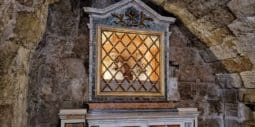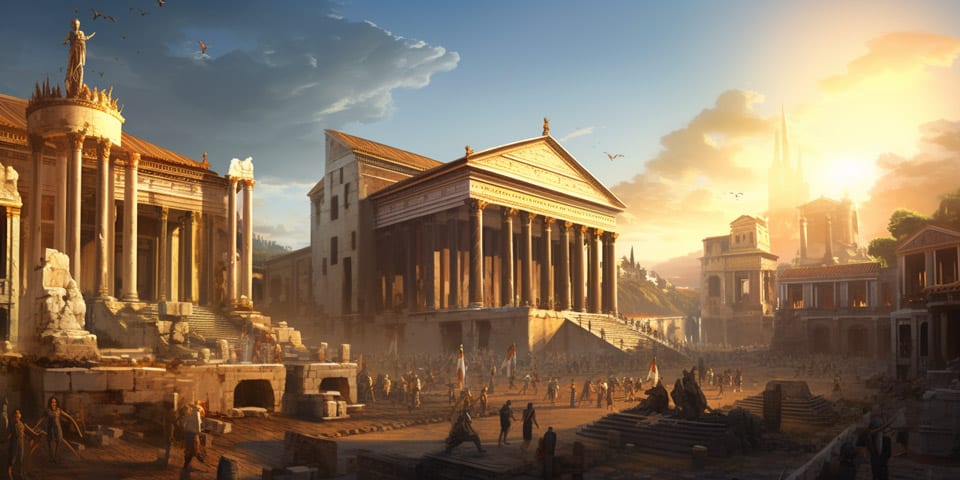
16433 views

There are a lot of ancient Roman architecture sites, and they are full of history. For example, the Eternal City has existed since 753 BC, and its architecture and works of art influenced the whole world.
In addition, there are many dignities in the ancient city, most of which you can find in the historic center. Moreover, some of them are free, while others you can visit by using Rome Passes or tickets.
Contents
Here’s the list of famous Roman ancient sites:
The Colosseum or Coliseum is perhaps the grandest construction in the history and culture of ancient Rome. It was created around 70-72 A.D. by Emperor Vespasian of the Flavian dynasty as a gift to the Roman people.
Moreover, the site had been the most prestigious place for entertainment in the capital and empire for four centuries.
Throughout the theater’s existence, two-thirds of the original construction has been destroyed and renovated several times. However, it remains one of the most famous tourist destinations in the world and an iconic symbol of Rome.
The Pantheon is an ancient temple dedicated to the Roman gods. Moreover, it is an embodiment of the greatness of the Roman Empire. It is assumed that the temple was built in 2 A.D. in the place of another temple, built in 27 B.C. by Marcus Agrippa. Moreover, the Pantheon is one of the few buildings of ancient Rome that have survived unchanged to this day.
Nowadays, this ancient crowning glory can be found at Piazza della Rotonda.
Interesting fact: Raphael wanted to be buried in the temple because according to him, it was a place where people and gods are united. The great artist was buried in the Pantheon. This event turned the temple into a burial place for great and famous people.
The Mausoleum of Hadrian, also known as Castel Sant’Angelo (The Castle of the Holy Angel), has a great view and impressive history. It was built at the dawn of Christianity on the banks of the Tiber River and served as the refuge for the Roman emperor, the residence of pontiffs, a fortress, then a prison, and later – the museum and treasury.
There is a legend that the Archangel Michael appeared above the mausoleum, putting his sword back into the sheath. Thus, the end of the plague in 590 A.D. was marked. To celebrate this, the tomb received its present name.
Interesting fact: In Italy and many other European countries, you have to say “God bless you!” to any person who had just sneezed. In the Middle Ages, it was believed that the plague began with sneezing attacks and only God could heal the plague of a sick person
The Theater of Marcellus (Teatro di Marcello) is a structure whose construction was started by Julius Caesar. It was finished by Augustus and dedicated to his favorite nephew Marcellus. The building is one of the ancient examples of important entertainment venues for Romans.
Marcellus’s Theater is the primary version of the Colosseum, but it is not the Colosseum, which is the original Roman amphitheater
The Circus Maximus is the giant racetrack of ancient Rome, situated on the left bank of the Tiber River, between the Palatine and Aventine hills, near the center of the modern city.
Moreover, Circo Massimo comes from the Latin Circus Maximus, where one of the meanings of the word “circus” is a hippodrome, a place for horse contests. Horse racing has been taking place for centuries in the valley between the hills.
However, the racetrack’s initial function was to host the Roman Games (Ludi Romani). The last race in the Circus Maximus was held in 549 AD, during the reign of Emperor Totila. However, after it, the era of destruction began.
Interesting fact: In the summer of 2014, a concert of the legendary music band Rolling Stones during their world tour took place on the Circus Maximus, which brought together 65,000 rock fans.
The Mouth of Truth (Bocca della Verita) is a Pavonazzo marble mask with a gloomy face of an unknown god set at the entrance of the Santa Maria church in Cosmedin. According to Medieval myth, the marble mask was used as a unique way of finding whether a person was telling the truth or not.
People who had committed crimes or were accused of committing crimes unfairly were brought in front of the mask. They were asked to take an oath and had to place their hand inside the sculpture’s open mouth while answering the executioner’s questions.
Ancient Romans believed that if a person were telling the truth, the mask would never move a muscle. However, if the person were telling a lie, the mouth would close and then cut off that person’s hand.
Interesting fact: The legend about the Mouth of Truth became famous when it was featured in “Roman Holiday” (1953). The mask was used as a storytelling device in the movie and exposed the truth about the myth
The ancient Roman Forum is a vast complex of triumphal arches, marble fragments, basilicas, ruined temples, and other architectural elements from different periods. Moreover, it was ancient Rome’s ceremonial, political, religious, and business center.
The forum provides insight into the splendor that previously was the Roman Empire.
Located above the Roman Forum, Capitoline Hill was the symbolic center of ancient Roma and held the Temple of Jupiter.
Moreover, today you can find the two oldest public museums in the world. The first is Palazzo Nuovo, with Greek and Roman sculptures, while the second is Palazzo dei Conservatori, where you will find art galleries, sculptures, and frescoes. The Capitoline Hills has the best view of the Eternal City’s historic center.
Note that one ticket gives you admission to both museums.
Three of Rome’s most extensive and essential catacombs are San Callisto, San Sebastiano, and Santa Domitilla.
Built between 250 and 300 A.D., the Catacombs of San Callisto (St. Callixtus) hold the graves of 500,000 Christians, including dozens of martyrs and 16 pontiffs.
The Catacombs of San Sebastiano are similar to the catacombs of San Calisto. They have four floors and different paintings, graffiti, and mosaics from the rise of Christianity.
These are among the most significant and ancient catacombs. The Catacombs of Santa Domitilla have four levels of graves and comprise 15 km (9.3 mi). Moreover, rich people were buried in decorated tombs of larger size, either individually or with their family members.
The Domus of Romulus and Remus was created in the second century B.C. It consists of the entrance that leads to the atrium (open-roofed entrance hall) with an impluvium (the square basin in the center of the atrium, which receives rainwater from an opening in the roof) surrounded by private rooms.
The house was excavated in the years 1871-72.
Interesting fact: During the excavation of the house, the bodies of five people were discovered. One of them died during the attempt to escape. He held numerous gold, silver, and bronze coins and rings in his hands.
The Baths of Diocletian were commissioned by Emperor Diocletian in 298 AD and had a capacity of more than 3000 people. Moreover, this bath complex was the largest in ancient Rome, and its structure was similar to that of the Baths of Caracalla.
Also, the Roman public baths operated until 537, when the Goths cut off the aqueducts to try to conquer Rome.
Interesting fact: During the construction of the Baths of Diocletian, thousands of enslaved Christians died, while Emperor Diocletian died in 305 because he was too tired and ill.
The construction of the Baths of Caracalla started in the year 212 by Emperor Caracalla.
It took about 5 years to finish them because a new aqueduct was built especially for the baths. The spa was not simply a place for bathing, sport, and health but also for relaxing and studying.
The Trajan’s Markets is a large complex of ruins created in the 2nd century A.D.. It is part of the Trajan’s Forum Moreover, Trajan’s Forum, along with the forums of Julius Caesar, Augustus, Nerva, and the Templum Pacis, were constituted the center of the Roman Empire.
Moreover, it is considered the world’s first shopping mall – all the shops and apartments were built in a multi-level structure; even nowadays, you can visit several levels.
Read more about shopping in Rome.
The Pyramid of Cestius is the tomb of praetor Caius Cestius Epulone. It was built in 12 B.C., the year of his death. It is 36.40 meters high and 30 square meters at the base.
It took 330 days to build the pyramid. Nowadays, the Pyramid of Cestius is located right near the metro station “Piramide.”
The stadium of Domitian (Stadio di Domoziano) was built in Rome as Tit Flaviy’s gift to Roman citizens, and was used for conducting different sports events.
Here, the second name of the stadium is Agons Arena, and Navona Square got its name thanks to this term. In the 1st century A.D., the stadium was called “Campus Agonis,” while closer to the Middle Ages, this form transformed into “n’agone.” Lastly, the name of the place was simplified to “Navona” So that, nowadays, this spot has become one of the most famous Roman squares – Piazza Navona.
Rome is full of ancient sites with rich history and exceptional beauty.
The city tells its story at every corner. It is undoubtedly worth discovering all these sites for yourself, but it will take several months or even years.
This website uses cookies. For more info read the cookies policy
Rome.us © 2025. Created with love by Roman experts and guides.